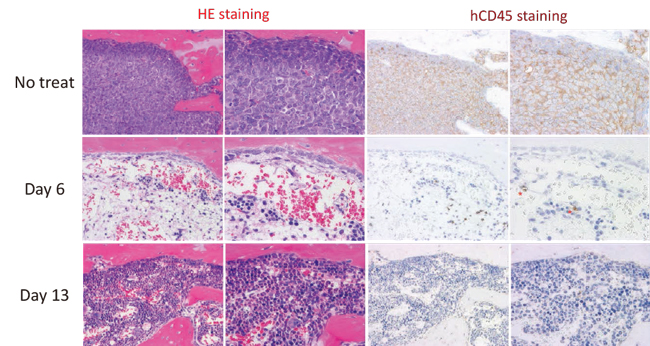Laboratory for Human Disease Models
Current research
Our laboratory has been creating humanized mice, by injecting human cord blood HSCs into immune-deficient NOD/SCID/Il2rgKO (NSG) newborns. Though the NSG humanized mouse model has enabled us to achieve high levels of human hematopoietic chimerism in multiple organs, limitations remain due to the species barrier between human immune cells and the mouse microenvironment. To overcome such limitations, in the past few years we have been developing mice with a more humanized microenvironment. We previously reported that human CD8+ T cells developed in HLA class I expressing NSG mice exhibited HLA-restricted functions such as cytokine production and cytotoxicity through recognition of EBV-infected B cells (Shultz, Saito, et al., PNAS 2010). Currently, we have been evaluating whether the HLA-expressing humanized mice could be a model to evaluate immune-therapy for malignancies.
In human leukemia research, to date, we reported that CD34+CD38- AML cells are largely cell cycle quiescent and are resistant to chemotherapy (Nature Biotechnology, 2007 & 2010). Furthermore, we found that HCK, a Src family kinase, was over-represented in human AML CD34+CD38- cells compared with normal CD34+CD38- HSCs (Science Translational Medicine 2010). Through large-scale library screening and in silico simulation for binding between HCK and small molecules, we identified a pyrrolo-pyrimidine compound, RK-20449, that can bind the ATP binding site of HCK and efficiently inhibit kinase activity of HCK. From in vitro experiments using 25 AML patient samples, we found that RK-20449 was effective especially against FLT3-ITD mutated AML cells. Finally, by using FLT3-ITD mutated AML engrafted humanized mice, we confirmed that in vivo administration of RK-20449 could almost completely eliminate human AML cells in the recipient circulation and in the recipient bone marrow. We concluded that RK-20449 is a promising agent for targeting FLT3-ITD mutated AML stem cells (Saito et al. Science Translational Medicine 2013).

Figure: A pyrrolo-pyrimidine compound eliminates human AML stem cells.
Histopathological examination with HE staining and immunohistochemical staining demonstrated that in vivo administration of RK-20449 resulted in elimination of human AML cells in NSG bone marrow over time. Normal mouse erythrocytes and myeloid cells recovered at day 6 and at day 13 while the number of human AML cells in the bone marrow was decreased. Human AML cells were stained with an anti-hCD45 antibody (brown).
